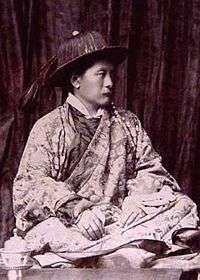Thutob Namgyal
Thutob Namgyal (Sikkimese: མཐུ་སྟོབས་རྣམ་རྒྱལ་; Wylie: mthu-stobs rnam-rgyal) (1860 – 11 February 1914) was the ruling chogyal (monarch) of Sikkim between 1874 and 1914. Thutob ascended to the throne succeeding his half-brother Sidkeong Namgyal who died issueless. Differences between the Nepalese settlers and the indigenous population during his reign led to the direct intervention of the British, who were the de facto rulers of the Himalayan nation. The British ruled in favour of the Nepalese much to the discontent of the chogyal, who then retreated to the Chumbi Valley and allied himself with the Tibetans.
| Thutob Namgyal | |
|---|---|
 | |
| Chogyal of Sikkim | |
| Reign | 1874 – 11 February 1914 |
| Predecessor | Sidkeong Namgyal |
| Successor | Sidkeong Tulku Namgyal |
| Born | 1860 |
| Died | 11 February 1914 (54–55) |
| Spouse | Yeshay Dolma |
| Issue | Sidkeong Tulku Namgyal Tashi Namgyal Mayeum Choying Wangmo Dorji |
| House | Namgyal dynasty |
| Father | Tsugphud Namgyal |
| Mother | Maharani Menchi |
| Religion | Buddhism |

The British sent a military force (Sikkim expedition), and after a series of skirmishes between the Tibetans and the British near Jelep La, the Tibetans were pushed back and the Chogyal was put under the supervision of John Claude White, who had been appointed Political Officer in 1889. In 1894, he shifted the capital from Tumlong to the present location, Gangtok. He was knighted in 1911. Alex McKay states, "The 9th Chogyal of Sikkim, Sir Thutob Namgyal, was increasingly supportive of modernisation. After his death in 1914, Sidkeon Namgyal Tulku, who had been groomed for the post by the British, succeeded him but died after ruling for just 10 months. Sidkeong Tulku’s younger half-brother, Tashi Namgyal, who had been educated at St Paul’s and Mayo College, then became Chogyal in 1915, and ruled Sikkim until his death in 1963."[1]
The Sir Thutob Namgyal Memorial (STNM) Hospital in Gangtok was built in memory of him in 1917.
Titles
Honours
British Empire
- KCIE: Knight Commander of the Order of the Indian Empire, 12 December 1911.
- Empress of India Gold Medal, 1 January 1877.
- Delhi Durbar Gold Medal, 1 January 1903.
- Delhi Durbar Golf Medal, 11 December 1911.
References
- McKay, Alex (2 February 2004). ""The indigenisation of western medicine in Sikkim" in The Bulletin of Tibetology" (PDF). University of Cambridge. p. 35. Archived from the original (PDF) on 31 March 2016. Retrieved 26 December 2017.
We have seen that the indigenisation process saw Western medicine take on aspects of traditional Sikkimese social structures, and this was particularly significant in regard to its patronage by the state’s traditional ruler. The 9th Chogyal of Sikkim, Sir Thutob Namgyal, was increasingly supportive of modernisation. After his death in 1914, Sidkeon Namgyal Tulku, who had been groomed for the post by the British, succeeded him but died after ruling for just 10 months. Sidkeong Tulku’s younger half-brother, Tashi Namgyal, who had been educated at St Paul’s and Mayo College, then became Chogyal in 1915, and ruled Sikkim until his death in 1963. Tashi Namgyal was, according to the British reports ‘deeply interested in medical affairs’, and in the early 1920s he and his wife (’the Maharani’ in British records), made a number of visits to the hospital in Gangtok, ‘and rendered every help possible.’ The Maharani even joined the Political Officer’s wife in organising classes at which local ladies might prepare garments for patients and so forth. This type of patronage continued into the post-colonial period.
"History of Sikkim". Home Department, Govt of Sikkim. Retrieved 1 July 2006.
| Wikimedia Commons has media related to Thutob Namgyal. |
Thutob Namgyal Born: 1860 Died: 11 February 1914 | ||
| Regnal titles | ||
|---|---|---|
| Preceded by Sidkeong Namgyal |
Chogyal of Sikkim 1874 – 1914 |
Succeeded by Sidkeong Tulku Namgyal |